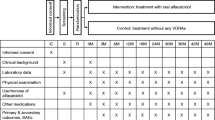Abstract
Background
Vitamin D deficiency is common among patients with chronic kidney disease (CKD). However, the benefits of vitamin D supplementation versus vitamin D receptor activator (VDRA) administration have yet to be established. Recently, an association between activated vitamin D and cardiovascular factors was reported. To evaluate the benefits of VDRA in advanced CKD, we analyzed the association between VDRA administration and the prevalence of pulmonary congestion.
Methods
This retrospective, cross-sectional analysis included patients initiated on dialysis between October 2011 and September 2013 at 17 Japanese institutions. Data from 952 participants were analyzed using a multivariate logistic regression model and a linear regression model. We also analyzed subgroup data for groups classified by selection of peritoneal dialysis or hemodialysis.
Results
Of the 952 participants, 303 patients received VDRA. VDRA administration was associated with a low prevalence of pulmonary congestion in the multivariate logistic regression model (odds ratio [OR], 0.64; 95 % confidence interval [CI], 0.44–0.94; P = 0.02). There was no significant association between VDRA administration and systolic blood pressure, diastolic blood pressure, or pulse pressure. Subgroup analysis revealed a tendency that VDRA administration was associated with low prevalence of pulmonary congestion in both groups.
Conclusions
In this study, VDRA administration was associated with a low prevalence of pulmonary congestion in patients initiated on dialysis. Appropriate VDRA administration may prevent pulmonary congestion.

Similar content being viewed by others
References
Jha V, Garcia-Garcia G, Iseki K, et al. Chronic kidney disease: global dimension and perspectives. Lancet. 2013;382:208.
LaClair RE, Hellman RN, Karp SL, et al. Prevalence of calcidiol deficiency in CKD: a cross-sectional study across latitudes in the United States. Am J Kidney Dis. 2005;45:1026–33.
Bhan I, Burnett-Bowie SA, Ye J, Tonelli M, Thadhani R. Clinical measures identify vitamin D deficiency in dialysis. Clin J Am Soc Nephrol. 2010;5:460–7.
Forman JP, Giovannucci E, Holmes MD, et al. Plasma 25-hydroxyvitamin D levels and risk of incident hypertension. Hypertension. 2007;49:1063–9.
Pittas AG, Dawson-Hughes B, Li T, et al. Vitamin D and calcium intake in relation to type 2 diabetes in women. Diabetes Care. 2006;9:650–6.
Jones G. Expanding role of vitamin D in chronic kidney disease: importance of blood 25-OH-D levels and extra-renal 1α-hydroxylase in the classical and nonclassical actions of 1α,25-dihydroxyvitamin D3. Semin Dial. 2007;20:316–24.
Mehrotra R, Kermah DA, Salusky IB. Chronic kidney disease, hypovitaminosis D, and mortality in the United States. Kidney Int. 2009;76:977–83.
De Boer I, Ioannou GN, Kestenbaum B, Brunzell JD, Weiss NS. 25(OH)D levels and albuminuria in the Third National Health and Nutrition Examination Survey(NHANES III). Am J Kidney Dis. 2007;50:69–77.
Martins D, Wolf M, Pan D, et al. Prevalence of cardiovascular risk factors and the serum levels of 25-hydroxyvitamin D in the United States: data from the Third National Health and Nutrition Examination Survey. Arch Intern Med. 2007;11:1159–65.
Liu LC, Voors AA, Van Veldhuisen DJ, et al. Vitamin D status and outcomes in heart failure patients. Eur J Heart Fail. 2011;13:615–25.
Fernández-Juárez G, Luño J, Barrio V, et al. 25 (OH) vitamin D levels and renal disease progression in patients with type 2 diabetic nephropathy and blockade of the renin-angiotensin system. Clin J Am Soc Nephrol. 2013;8:1870–6.
Wolf M, Shah A, Gutierrez O, et al. Vitamin D levels and early mortality among incident hemodialysis patients. Kidney Int. 2007;72:1004–13.
Holick MF. Vitamin D deficiency. N Engl J Med. 2007;357:266–81.
Wang L, Manson JE, Song Y, Sesso HD. Systematic review: vitamin D and calcium supplementation in prevention of cardiovascular events. Ann Intern Med. 2010;152:315–23.
Li YC. Vitamin D regulation of the renin-angiotensin system. J Cell Biochem. 2003;88:327–31.
Kilickesmez KO, Abaci O, Okcun B. Chronic kidney disease as a predictor of coronary lesion morphology. Angiology. 2010;61:344–9.
Patange AR, Valentini RP, Gothe MP, Du W, Pettersen MD. Vitamin D deficiency is associated with increased left ventricular mass and diastolic dysfunction in children with chronic kidney disease. Pediatr Cardiol. 2013;34:536–42.
Kandula P, Dobre M, Schold JD, Schreiber MJ Jr, Mehrotra R, Navaneethan SD. Vitamin D supplementation in chronic kidney disease: a systematic review and meta-analysis of observational studies and randomized controlled trials. Clin J Am Soc Nephrol. 2011;6:50–62.
Teng M, Wolf M, Lowrie E, Ofsthun N, Lazarus JM, Thadhani R. Survival of patients undergoing hemodialysis with paricalcitol or calcitriol therapy. N Eng J Med. 2003;31:446–56.
Tentori F, Hunt WC, Stidley CA. For the medical directors of Dialysis Clinic Inc: mortality risk among hemodialysis patients receiving different vitamin D analogs. Kidney Int. 2006;70:1858–65.
Miller JE, Molnar MZ, Kovesdy CP, et al. Administered paricalcitol dose and survival in hemodialysis patients: a marginal structural model analysis. Pharmacoepidemiol Drug Saf. 2012;21:1232–9.
Acknowledgments
We acknowledge the support of the following investigators, members of the Aichi cohort study of prognosis in patients newly initiated into dialysis (AICOPP), who participated in this study: Hirofumi Tamai (Anjo Kosei Hospital), Tomohiko Naruse (Kasugai Municipal Hospital), Kei Kurata (Tosei General Hospital), Hideto Oishi (Komaki City Hospital), Isao Aoyama (Social Insurance Chukyo Hospital), Hiroshi Ogawa (Shinseikai Daiichi Hospital), Hiroko Kushimoto(Chita City Hospital), Hideaki Shimizu (Chubu-Rosai Hospital), Junichiro Yamamoto (Tsushima City Hospital), Hisashi Kurata (Toyota Kosei Hospital), Taishi Yamakawa (Toyohashi Municipal Hospital), Takaaki Yaomura (Nagoya Medical Center), Hirotake Kasuga (Nagoya Kyouritsu Hospital), Shizunori Ichida (Japanese Red Cross Nagoya Daiichi Hospital), Shoichi Maruyama (Nagoya University Graduate School of Medicine), Noritoshi Kato (Nagoya University Graduate School of Medicine), Seiichi Matsuo (Nagoya University Graduate School of Medicine), Shigehisa Koide (Fujita Health University Hospital), and Yukio Yuzawa (Fujita Health University Hospital).
Conflict of interest
The authors have declared that no conflict of interest exists.
Author information
Authors and Affiliations
Consortia
Corresponding author
About this article
Cite this article
Sueta, S., Morozumi, K., Takeda, A. et al. Ability of vitamin D receptor activator to prevent pulmonary congestion in advanced chronic kidney disease. Clin Exp Nephrol 19, 371–378 (2015). https://doi.org/10.1007/s10157-014-0994-x
Received:
Accepted:
Published:
Issue Date:
DOI: https://doi.org/10.1007/s10157-014-0994-x




